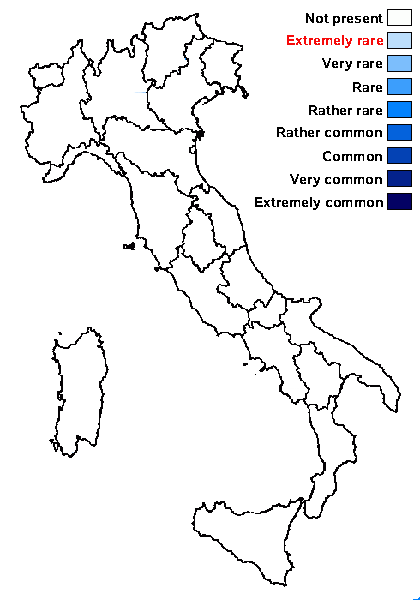Pseudobogoriella pachnea (Körb.) Lücking, R. Miranda & Aptroot
in Hongsanan & al., Fungal Divers.: 10.1007/s13225-020-00462-6,, 172, 2020. Basionym: Microthelia pachnea Körb. - Parerga Lichenol., 5: 398, 1865
Synonyms: Amphisphaeria pachnea (Körb.) Rehm; Mycomicrothelia pachnea (Körb.) D. Hawksw.
Distribution:
Description: Thallus crustose, endosubstratic, usually poorly evident, appearing as a whitish patch on bark, not delimited by a dark line. Perithecia black 0.2-0.3 mm across, scattered, immersed in the periderm with only the ostiolar region exposed, hemispherical to flattened at top, with a dark reddish brown, 15-25 µm thick (around the ostiole) involucrellum reacting K+ olive-green, limited to the upper 2/3 of the perithecium and not confluent with exciple in lower part, rarely extending laterally up to the base into an indistinct basal fringe, formed of incorporated bark cells and irregularly radially oriented, 2.5-4(-5) µm thick, red brown cells. Exciple composed of 3-4 layers of subhyaline, interwoven, c. 2 µm thick hyphae, forming a 5-10 µm thick layer. Hamathecium of branched and anastomosing, filiform, septate, 2-3 µm thick pseudoparaphyses; hymenial gel I-. Asci 8-spored, elongate-clavate, bitunicate, fissitunicate, with a non-amyloid ocular chamber. Ascospores 1-septate, strongly constricted at septum, grey-brown, sole-shaped, the upper cell larger, broader and rounded, the lower cell smaller, narrower and sometimes more attenuated, 15-18 x 6-9 µm, the wall warted, often with a 1-2 µm thick gelatinous sheath swelling in K. Pycnidia unknown. Photobiont absent or thallus hyphae loosely associated with Trentepohlia. Spot tests: thallus K-, C-, KC-, P-, UV-. Chemistry: without lichen substances.Note: a facultatively lichenized, largely overlooked species known from Austria and Spain, on Abies and (doubtfully) Quercus. To be looked for in Italy.
Growth form: Crustose
Substrata: bark
Photobiont: Trentepohlia
Reproductive strategy: mainly sexual

Predictive model
Growth form: Crustose
Substrata: bark
Photobiont: Trentepohlia
Reproductive strategy: mainly sexual

Predictive model
 Index Fungorum
Index Fungorum
 GBIF
GBIF

